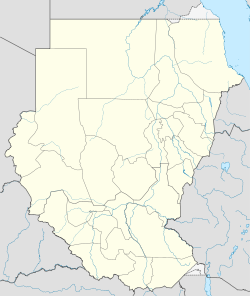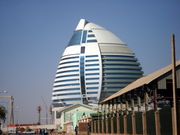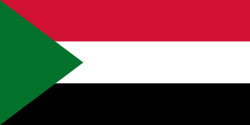Khartoum
| Khartoum الخرطوم al-Kharṭūm |
|||
|---|---|---|---|
 |
|||
|
|||
| Nickname(s): The Triangular City | |||
 Khartoum
|
|||
| Coordinates: | |||
| Country | |||
| State | Khartoum State | ||
| Government | |||
| - Governor | Abdul Rahman Alkheder | ||
| Population (2005) | |||
| - Urban | 2,207,794 | ||
| - Metro | 11,000,000 Agglomeration | ||
Khartoum (الخرطوم al-Kharṭūm) is the capital of Sudan and of Khartoum State. It is located at the confluence of the White Nile flowing north from Lake Victoria, and the Blue Nile flowing west from Ethiopia. The location where the two Niles meet is known as "al-Mogran". The main Nile continues to flow north towards Egypt and the Mediterranean Sea.
Divided by the Niles, Khartoum is a tripartite metropolis with an estimated overall population of over a million people consisting of Khartoum proper, and linked by bridges to Khartoum North called (al-Khartūm Bahrī) and Omdurman (Umm Durmān) to the west.
Contents |
Etymology
The word 'Khartoum' is derived from Arabic Al-Jartūm الجرطوم meaning "end of an elephant’s trunk", probably referring to the narrow strip of land extending between the Blue and White Niles.[1] Captain J. A. Grant, who reached Khartoum in 1863 with Captain Speke’s expedition, thought that the derivation was most probably from the safflower (Carthamus Tinctorius L.) which is called 'Gartoon,' and which was cultivated extensively in Egypt for its oil, used in burning.
History
Early history
Ibrahim Pasha, the ruler of Egypt, founded Khartoum in 1821 as an outpost for the Egyptian Army. The settlement grew as a regional center of trade, including the slave trade. Troops loyal to the Mahdi Muhammad Ahmad began a siege of Khartoum on 13 March 1884 against the defenders led by British General Charles George Gordon. The siege ended in a massacre of the Anglo-Egyptian garrison.
The heavily damaged city fell to the Mahdists on 26 January 1885. Omdurman was the scene of the bloody battle on 2 September 1898, during which British forces under Herbert Kitchener defeated the Mahdist forces defending the city.
In 1899, Khartoum became the capital of Anglo-Egyptian Sudan. Several explanations have been offered for the design of the new, Anglo-Egyptian Khartoum. One is that Kitchener laid out the city's streets in a Union flag pattern as a symbol of British dominance. Another is that the grid system and diagonal streets of the city were designed to converge in a way that would allow machine-guns to sweep the town. However, there is no contemporary evidence to support either of these suggestions.[2]
When Sudan became independent in 1956, Khartoum became the capital of the new country.
Recent history
_003.jpg)

In 1973, the city was the site of an anomalous hostage crisis in which members of Black September held ten hostages at the Saudi embassy, five of whom were diplomats. The US ambassador, the US deputy ambassador, and the Belgian chargé d'affaires were murdered. The remaining hostages were released (see 1973 Khartoum diplomatic assassinations). A 1973 United States Department of State document, declassified in 2006, concluded "The Khartoum operation was planned and carried out with the full knowledge and personal approval of Yasser Arafat."[3]
The first oil pipeline between Khartoum and Port Sudan was completed in 1977.
Throughout the 1970s and 1980s, Khartoum was the destination for hundreds of thousands of refugees fleeing conflicts in neighbouring nations such as Chad, Eritrea, Ethiopia and Uganda. The Eritrean and Ethiopian refugees assimilated into society which some of the other refugees settled in large slums at the outskirts of the city. From the mid-1980s onward, large numbers of South Sudanese and Darfuri internally displaced from the violence of the Second Sudanese Civil War and Darfur conflict have settled around Khartoum.
Following the 1998 U.S. embassy bombings, the United States accused Osama bin Laden's al-Qaeda group of responsibility and launched cruise missile attacks (20 August) on the al-Shifa pharmaceutical factory in Khartoum North. The destruction of the factory produced diplomatic tension between the U.S. and Sudan. The ruins of the factory are a tourist attraction.
After the sudden death of SPLA head and vice-president of Sudan John Garang at the end of July 2005, there were violent riots in the capital for three days which died down after Southern Sudanese politicians and tribal leaders sent strong messages to the rioters. ĤĤThe situation could have been chaotic with mass killings and reprisals however the death toll was at least 24 as youth from South Sudan attacked North Sudanese and clashed with security forces.[4]
The Organisation of African Unity summit of July 18–22, 1978 was held in Khartoum, during which Sudan was awarded the OAU presidency. The African Union summit of January 16–24, 2006 was held in Khartoum.
The Arab League summit of March 28–29, 2006 was held in Khartoum, during which the Arab League awarded Sudan the Arab League presidency.
On 10 May 2008 the Darfur rebel group of the Justice and Equality Movement moved into the city where they engaged in heavy fighting with Sudanese government forces. Their soldiers included minors and their goal was the toppling of Omar Hassan al-Bashir's government, though the Sudanese government succeeded in beating back the assault.[5][6][7]

Climate
Khartoum features a hot arid climate, with only the months of July and August seeing significant precipitation. Khartoum averages a little over 155 mm (6 in.) of precipitation per year. Based on average annual temperatures, Khartoum is quite possibly the hottest major city on the planet. Temperatures may exceed 53°C (127°F) in mid-summer. Its average annual high temperature is 38°C (100°F), with seven months of the year seeing an average monthly high temperature of at least 38°C (100°F). Furthermore, none of its monthly average high temperatures falls below 30°C (86°F). This is something not seen in other major cities with hot arid climates such as Riyadh, Baghdad and Phoenix. Temperatures cool off considerably during the night, with Khartoum's lowest average low temperatures of the year hovering around the 16°C (60°F) mark.
| Climate data for Khartoum | |||||||||||||
|---|---|---|---|---|---|---|---|---|---|---|---|---|---|
| Month | Jan | Feb | Mar | Apr | May | Jun | Jul | Aug | Sep | Oct | Nov | Dec | Year |
| Average high °C (°F) | 30.8 (87.4) |
33.0 (91.4) |
36.8 (98.2) |
40.1 (104.2) |
41.9 (107.4) |
41.3 (106.3) |
38.4 (101.1) |
37.3 (99.1) |
39.1 (102.4) |
39.3 (102.7) |
35.2 (95.4) |
31.8 (89.2) |
37.1 (98.8) |
| Average low °C (°F) | 15.6 (60.1) |
17.0 (62.6) |
20.5 (68.9) |
23.6 (74.5) |
27.1 (80.8) |
27.3 (81.1) |
25.9 (78.6) |
25.3 (77.5) |
26.0 (78.8) |
25.5 (77.9) |
21.0 (69.8) |
17.1 (62.8) |
22.7 (72.9) |
| Precipitation mm (inches) | 0 (0) |
0 (0) |
0 (0) |
0 (0) |
0.4 (0.016) |
4.0 (0.157) |
46.3 (1.823) |
75.2 (2.961) |
25.4 (1) |
4.8 (0.189) |
0.7 (0.028) |
0 (0) |
156.8 (6.173) |
| Avg. precipitation days | 0 | 0 | 0.1 | 0.1 | 0.9 | 1.2 | 4.8 | 4.8 | 3.2 | 1.2 | 0 | 0 | 16.3 |
| Sunshine hours | 341 | 311 | 310 | 330 | 300 | 300 | 279 | 279 | 300 | 310 | 330 | 341 | 3,731 |
| Source #1: World Meteorological Organisation (UN) [8] | |||||||||||||
| Source #2: BBC Weather [9] | |||||||||||||
Demographics
| Year | Population[10] | |
|---|---|---|
| City | Agglomeration | |
| 1907[11] | 69,349 | k. A. |
| 1956 | 93,100 | 245,800 |
| 1973 | 333,906 | 748,300 |
| 1983 | 476,218 | 1,340,646 |
| 1993 | 947,483 | 2,919,773 |
| 2008 Census Preliminary | 1,410,858[12] | 4,272,728[12] |
Economy
_001.jpg)

After the signing of the historic Comprehensive Peace Agreement between the government of Sudan and the Sudan People's Liberation Movement (SPLA), the Government of Sudan has begun a massive development project.[13][14] The biggest projects taking place right now in Khartoum are the Al-Mogran Development Project, two five-star hotels, a new airport, Mac Nimir Bridge (finished in October 2007) and the Tuti Bridge that links Khartoum to Tuti Island.
Khartoum has a thriving economy. In recent years Khartoum has seen significant development, driven by Sudan's oil wealth. The center of the city is well-planned, with tree-lined streets. However, Khartoum has the highest concentration of economic activity in the country. This is slowly changing as major economic developments take place in other parts of the country, like oil exploration in the South, the Giad Industrial Complex and White Nile Sugar Project in Central Sudan, and the Merowe Dam in the North.
Among the city's industries are printing, glass manufacturing, food processing, and textiles. Petroleum products are now produced in the far north of Khartoum state, providing fuel and jobs for the city. One of Sudan's largest refineries is located in northern Khartoum. Moreover, a number of East-Asian companies have recently shown interest in the realization of a new project which will lead to the creation of new telecommunication services throughout the country.
Education
Khartoum is the main location for most of Sudan's top educational bodies, including but not limited to:
High Schools
- Khartoum Old High Secondary School for Boys
- Khartoum Old High Secondary School for Girls
- Khartoum International Community School, KICS
- Unity High School. The school came to international attention on 25 November 2007 when one of its teachers, Gillian Gibbons from Liverpool, England, was arrested by Sudanese authorities for allegedly insulting Islam by allowing the children in her class to name a teddy bear "Muhammad".[15][16]
- Comboni, Khartoum American School and St. Francis
Universities
- University of Khartoum. Founded as Gordon Memorial College in 1902, it was later renamed to share the name of the city in the 1930s.
- Juba University, relocated from Juba during the civil war. Currently, one of the universities in Sudan that maintains English as the language of instruction. Plans exist to relocate the university or part of it back to Southern Sudan.
- Computerman College, the college for computer studies, which recently added other departments.
- Al Neelain University
- Sudan University of Science and Technology. One of the main engineering and technical schools in Sudan, founded in 1932 as Khartoum Technical Institute and given its present name in 1991.
- University Of Science & Technology one of better university in computer tecgnology and medical science.
- Bayan Science and Technology University
- The Academy of Medical Sciences and Technology. Better known as AMST, it was founded in 1996 by Prof. Mamoun Humaida and built in Khartoum.
- Omdurman Islamic University
- Ahfad University for Women
- Academy of Medical Sciences and Technology, Khartoum
- Comboni College for Science and Technology, Khartoum
Transportation
Air
Khartoum is home to the largest airport in Sudan, Khartoum International Airport. It is the main hub for Sudan Airways, Sudan's main carrier. The airport was built at the southern edge of the city; but with Khartoum's rapid growth and consequent urban sprawl, the airport is now located in the heart of the city. A new international airport is currently being built in the city of Omdurman. It will replace the current airport in Khartoum as Sudan's main airport followed by Juba Airport and Port Sudan Airport.
Bridges
The following bridges cross the Blue Nile and connect Khartoum to Khartoum North:
- Mac Nimir Bridge
- Blue Nile Road & Railway Bridge
- Kober Bridge
- Elmansheya Bridge
The following bridges cross the White Nile and connect Khartoum to Omdurman:
- White Nile Bridge
- Fitayhab Bridge
- Al Dabbaseen Bridge (Under Construction)
- Omhuraz Bridge (Proposed)
the following bridges cross from Omdurman: to Khartoum North:
- Shambat Bridge
- Halfia Bridge (Under Construction)
The following bridges cross to Tuti from Khartoum states three cities
- Khartoum-tuti bridge
- Omdurman-Tuti Suspension bridge proposed
- Khartoum North-tuti bridge proposed
Rail
Khartoum has rail lines from Egypt, Port Sudan and El Obeid.also it rail lines extended to some parts of south Sudan
Culture

Museums
The largest museum in Khartoum, and indeed all of Sudan, is the National Museum of Sudan. Founded in 1971, it contains works from different epochs of Sudanese history. Among the exhibits are two Egyptian temples of Buhen and Semna which were originally built by Queen Hatshepsut and Pharaoh Tuthmosis III respectively but relocated to Khartoum upon the flooding of Lake Nasser.
Another museum in Khartoum is the Palace Museum, located adjacent to the historical Presidential Palace on Blue Nile Street.
Shopping
Khartoum doesn't have as many open markets or souqs as neighboring Omdurman, but one of the largest is the Souq Arabi. The market is huge and spread over several blocks in the center of Khartoum proper just south of the Great Mosque (Mesjid al-Kabir) and the minibus station. It is divided into separate sections, including one focused entirely on gold.
Al Qasr St. and Al Jamhoriyah St. are considered the most famous high streets in Khartoum State.
Recently Sudan's first medium scale shopping mall opened, located in the southern suburb Arkeweet. The Afra Mall has a supermarket, retail outlets, coffee shops, a bowling alley, movie theaters, and a children's playground.
Also recently Sudan opened the Hotel Section and part of the food court of the new, Elfatih Tower. The Mall/Shopping section is still under construction.
Botanical gardens
Khartoum is home to a small botanical garden, in the Mogran district of the city.
Clubs

Khartoum is home to several clubs such as the Sailing Club, German Club, Greek Hotel, Coptic Club, Syrian Club, International Club etc.
Twin cities
 Amman, Jordan.
Amman, Jordan. Cairo, Egypt.
Cairo, Egypt. Istanbul, Turkey.
Istanbul, Turkey. Ankara, Turkey.
Ankara, Turkey. Saint Petersburg, Russia.
Saint Petersburg, Russia. Wuhan, People's Republic of China.
Wuhan, People's Republic of China. Asmara, Eritrea.
Asmara, Eritrea. Omdurman, Sudan.
Omdurman, Sudan.
See also
- Khartoum, a 1966 film starring Charlton Heston and Laurence Olivier
- Al-Mogran Development Project
References
- ↑ Room, Adrian (2006), Placenames of the World (Second edition)., McFarland. ISBN 0786422483. p. 194
- ↑ Home, Robert K., Of Planting and Planning: the making of British colonial cities (1997), p.41
- ↑ "The Seizure of the Saudi Arabian Embassy in Khartoum". U.S. Department of State. 2006-05-04. http://www.state.gov/documents/organization/67584.pdf.
- ↑ "World | Africa | Riots after Sudan VP Garang dies". BBC News. 2005-08-01. http://news.bbc.co.uk/1/hi/world/africa/4734517.stm. Retrieved 2010-06-27.
- ↑ Curfew in capital as Sudanese army clash near Khartoum with Darfur rebels – Sudan Tribune 2008-05-10
- ↑ Sudanese rebels 'reach Khartoum' – BBC News 2008-05-10
- ↑ PHOTOS: Sudan capital after today's attack from Darfur JEM – Sudan Tribune 2008-05-10
- ↑ "World Weather Information Service - Khartoum". UN. http://worldweather.wmo.int/085/c00249.htm. Retrieved 2010-05-06.
- ↑ "Average Conditions Khartoum, Sudan". BBC Weather. http://www.bbc.co.uk/weather/world/city_guides/results.shtml?tt=TT000640. Retrieved August 21, 2009.
- ↑ "http". //bevoelkerungsstatistik.de. http://bevoelkerungsstatistik.de/wg.php?x=&men=gcis&lng=de&dat=32&geo=-188&srt=npan&col=aohdq&pt=c&va=x.&srt=pnan. Retrieved 2010-06-27.
- ↑ "Encyclopedia Britannica von 1911: Band 15, Seite 773". Encyclopedia.jrank.org. http://encyclopedia.jrank.org/KHA_KRI/KHARTUM.html. Retrieved 2010-06-27.
- ↑ 12.0 12.1 http://www.citypopulation.de/Sudan.html
- ↑ "Sudan and UNDP launch Millennium Goals project". Sudan Tribune. 20075-09-05. http://www.sudantribune.com/spip.php?page=imprimable&id_article=11484. Retrieved 2008-06-28.
- ↑ "Khartoum booms as Darfur burns". BBC. 2007-04-24. http://news.bbc.co.uk/2/hi/africa/6573527.stm. Retrieved 2008-06-28.
- ↑ "'Muhammad' teddy teacher arrested". BBC. 2007-11-26. http://news.bbc.co.uk/1/hi/world/africa/7112929.stm. Retrieved 2007-11-28.
- ↑ Rob Crilly in Khartoum and Lucy Bannerman (2007-11-27). "Sudan police throw teacher in jail for teddy bear named Muhammad". The Times. http://www.timesonline.co.uk/tol/news/world/africa/article2951262.ece. Retrieved 2007-11-28.
External links
- Khartoum travel guide from Wikitravel
|
||||||||||||||||||||||||||
